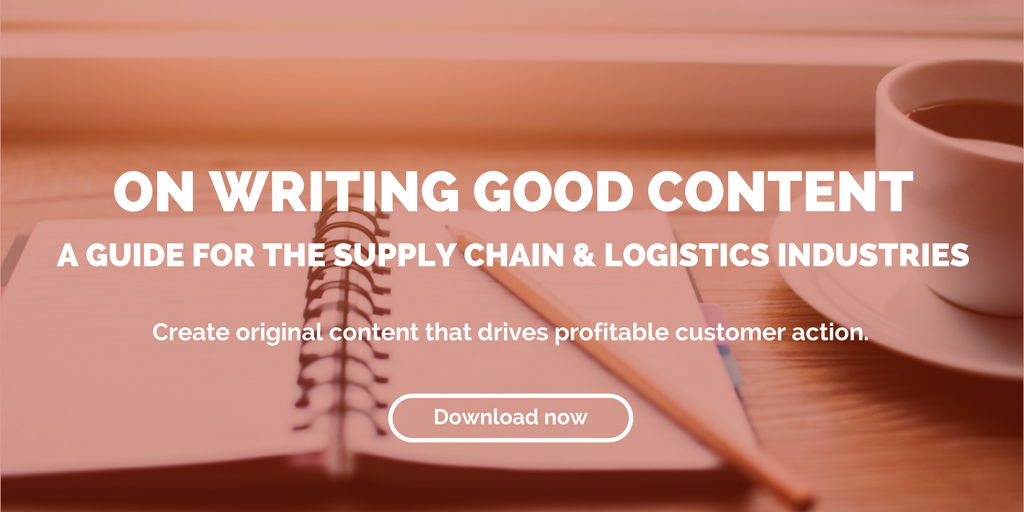
by Fronetics | Nov 4, 2015 | Blog, Content Marketing, Marketing, Supply Chain
3 things supply chain hiring managers should look for when hiring a copywriter.
Since 94% of domestic B2B buyers conduct research online to make purchase decisions, maintaining high-quality content on your company’s website is crucial for attracting new business. But who has time for web upkeep, much less for the generation of new blog posts, emails, and various other content? Enter the copywriter.
An effective copywriter can help drive consumers to your website, convince them of the quality of your products/services, and ultimately help convert those leads into customers. A lot of writers can do one of these functions. The gold standard, of course, is a copywriter with a proven track record in all three functions.
How do you know if a copywriter will be effective for your business? Here are a few specific skills and experiences supply chain hiring managers should look for in a potential hire:
Someone who understands SEO.
An SEO-savvy copywriter can impact your business by increasing the number of visitors (i.e., potential customers) to your site. That’s because 77% of today’s buyers use Google to research information about products.
A copywriter trained in search engine optimization (SEO) knows how to write and format your site so it gets prioritized by Google in web queries for your products. Three of four people will click on the top five search results. So the closer you can be to those top five results, the better your chances at driving a buyer to your site. That’s a crucial first step in converting that lead into a new customer.
Look for SEO training or experience on a potential copywriter’s resume. And ask for any metrics illustrating how his/her search-engine-optimized content has increased organic traffic to a client’s website. A copywriter who understands SEO can help achieve the same result for you over time.
Someone who understands branding.
Sure, it’s great if you can find a copywriter with experience in the supply chain — the vocabulary and industry knowledge are already in place. But, likely, a solid writer who has developed content for a variety of industries has the technical skills and resourcefulness to get up to speed quickly.
Consider the value of a candidate who also has marketing writing and branding experience. This person has the know-how to create content driven by your business objectives and a mind for strategy that can promote your image among consumers and other businesses.
A 2015 global study on B2B branding has shown its positive impact on the perceived quality of a product and creation of new market opportunities. Branding instills confidence and trust among consumers.
The marketing copywriter can craft a consistent, compelling brand narrative across all of your digital channels. That means your website, blog posts, white papers, social media, emails, etc., will work together to solidify and enhance your business’s reputation in the marketplace, which will serve you beyond any individual campaign.
Someone who understands user experience.
User experience plays a vital role in conversion: the more positive the customer’s interaction with your business, the more motivated s/he will be to purchase from you. Additionally, Gartner Research estimates that by 2020 customers will manage 85% of their relationship without talking to a human. That means your web content will bear most of the user-experience burden.
A copywriter who understands user experience anticipates what buyers are seeking at any given point on your website and adjusts the copy so that the answer is clear and easy to find. Paragraphs of dense, technical copy on a product page could easily turn a buyer away, for example. A well-placed, well-written call-to-action, however, could lead to a purchase.
To find a copywriter who understands user experience, look for content that is not only polished, but also helpful, persuasive, and, above all, accessible. Writing samples should reflect where in the sales cycle a user would encounter it. That candidate could play a vital role in helping you convert leads into customers.
Hiring a copywriter represents an opportunity to bring someone on board who can do more than produce content: they can help achieve your business goals.
Related posts:


by Jennifer Hart Yim | Jul 27, 2015 | Blog, Marketing, Social Media, Supply Chain

Editor’s note: This is a guest post written by David Weaver. David has spent the past several years developing a best practice online marketing strategy for the inventory and supply chain division at INFORM GmbH.
Blogging has been around for years, yet some of the most basic questions regarding this communication method are still being asked. In fact, it has been around so long that some people are even asking the question “Is blogging dead?” My answer to that provocative question is of course no, but the blogging world is evolving. Despite the ever changing playing field, one of the most important success factors to blogging is to always keep the target audience in mind when writing an article. If content is not focused and targeted, a blog platform may actually experience a slow and agonizing death.
I started blogging in 2012, relatively late considering the concept has its roots in the 1990’s. Over the past three years, I have had the opportunity to network with some top bloggers as well as newcomers on the blogging scene. Whether I was the one asking or answering the questions, five common themes come up in the majority of blogging discussions I have been a part of. While the questions may be “basic” the answers, in my opinion, are not always easy:
-
What is the point?
This is a question I like to ask myself every time I write a new article. If I am not delivering either a fresh take on an existing topic or offering unique insights, I tend to rethink the purpose of the article. Regarding blogging in general, from a business perspective, numerous benefits can be realized:
- Expansion of online reach
- Lead generation
- Increased SEO presence
- Improved image
- Thought-Leadership
- Increased networking opportunities
-
Is it too late to start?
No. I recently attended a content marketing event, and next to “ephemeral media”, the topic of influencer marketing was heavily featured. The majority of attendees agreed that everyone is an influencer with a network of friends, family, colleagues and acquaintances. Blogging serves as outlet for the expression of this influence.
The good news is that there are a multitude of blogs already out there looking for contributors, so you don’t have to create something from scratch. As an example, if you are a supply chain professional wanting to share your experience on the topic of supplier relationship management, simply type in “supply chain blog” in Google and you will find several platforms that would be happy to hear from you.
-
How do I stay motivated/come up with ideas?
Next to actually starting to write, one of the most difficult tasks is writing a new article when the previous article you posted received little to no attention. This is often the case in the early stages of the blogging process and can be very discouraging. A discouraged writer will consequently have trouble in the idea development stage. Some ways to stay motivated and keep the creative juices flowing include:
- Brainstorming with family and friends
- Scanning Social Media for trending topics
- Asking readers and other industry experts for feedback
- Starting a blog series that will leave readers wanting more
- Varying your content and include videos, infographics and guest bloggers
If you are new to blogging, always keep in mind that the journey is long and developing a following/readership will take time. Don’t give up!
-
How often should I post?
The answer to this question is easy: it depends. There are differing opinions on this subject and the general rule of thumb is also vague, namely “post regularly.” My stance on the matter is that quality trumps quantity. If an article seems forced or does not bring something new to the table, it is best to allow the idea to mature and deliver a comprehensive article at a later date instead of posting to meet a deadline.
When starting out, it is best to set achievable goals i.e. “I will post one article per week.” On my first blog project, I set the goal of publishing an original article every Monday. This provided consistency for the readers and gave me time to develop new ideas.
-
How do I deal with critics?
I believe the fear of putting oneself out on the web is one of the highest hurdles to publishing articles on blog platforms. The fact is, there will be people that disagree with your opinion. The deciding factor is how you deal with the criticism. Getting into a name-calling, heated argument with an internet troll is not recommended and can only lead to a damaged reputation. With regard to constructive criticism and differing opinions, it is important to acknowledge the difference and remain professional. This includes respecting the other person’s opinions. In the end, it may be best to “agree to disagree”.
Closing thoughts
Aside from the purposes mentioned under “What is the point,” I use various blog platforms as a way to start a conversation and learn from others. Blogging is time consuming and hard work, but in my opinion, the benefits far outweigh the costs. My questions to you: If you are not blogging, why not? If you are blogging, what are some open questions you have?

by Jennifer Hart Yim | Jun 11, 2015 | Blog, Content Marketing, Marketing
This is a guest post written by Thijs Messelaar. Thijs has more than 15 years’ experience writing, developing content, and informing marketing strategy for various clients, including high tech, higher education, and highly-rated restaurants.
 The best content marketing feels like a great story.
The best content marketing feels like a great story.
In fact, in many ways content marketing gets the most results because it IS a great story. It captures your imagination. It challenges you. It asks for your trust. And, if it’s truly tops, the payoff is big.
In order to get results from your content, a solid content marketing strategy must be in place. No doubt about it. Simply just creating incredible content and walking away from it probably isn’t going to get you what you want.
Key Content Marketing Channels
Content marketing requires a careful scientific approach in order to get results. Content needs to be curated, cajoled, packaged, posted, pruned, repurposed, prettified, shared, shorn, shifted, pushed out, and run up the flagpole.
To get results from your content, your content will have to be created for and/or distributed through key marketing channels like these:
- Your website assets
- Blog
- Landing pages
- Case studies
- Team (clout)
- Accolades and awards
- Resources
- Videos
- Surveys and quizzes
- Infographics
- E-books
- White papers
- Email
- SEO (onsite)/SEM (AdWords)
- Apps
- Social media (organic)
- Retargeted ads (web and social media)
- Social media ads, promoted posts, offers
- Webinars, trainings, and mini-courses
- Podcasts (audio and video)
You need to organize and optimize your sales pipeline by identifying your goals, audience, and your content marketing channels. And like a good scientist, you’ll have to analyze your results and revise your approach, over and again and again.
Examining all aspects of your content marketing strategy – creation, distribution, engagement – on your content marketing ROI is essential.
The Magic of Content Marketing
But without producing the most interesting, the most useful, the most delicious writing, design and ideas to place in these various channels, your content marketing will be dead in the water.
Great content marketing moves you to do something new and unfamiliar. Or it makes you understand something familiar in a new way. And like a really good story, you want to share good content with everyone. It’s affirming (or reaffirming) and engaging and makes you feel its magic. The magic of content marketing that gets results may be found in the sense of clear authority it imparts.
But the magic of a great story is something intangible. It comes from a true place within you (your soul, let’s say) – and connects with your audience (their souls).
But much of the best content marketing is built on novel, engaging, social, physical, and emotional experiences – not solely on rote data analysis.
Douglas Van Praet advances this relatively controversial take on current marketing practices. “We need to generate smiles, tears, or goose bumps—not significant differences correlated at the 95% confidence interval! These are the things that […] data tabulations will never capture, but they are also the things that make us buy brands,” he writes.
Likewise, these key content marketing attributes are also the essential characteristics of our most favorite and enduring stories.
If yours is merely content created for the sake of just churning more content – that is, if you don’t care much for what you’re writing about – your audience won’t care much either. It will curdle the moment they consume it.
Without moving your audience emotionally, you won’t have excited them intellectually, you won’t have made them care about you or gained their valuable (and venerable) trust. And surely your audience won’t hold your story “near-and-dear” to their hearts in a way that compels them to retell it to everyone and anyone who will listen.
The overall result? Well, poor results from your content marketing and ultimately a weakening of your brand’s standing.
Start your content creation from the soul by being yourself and talking about what you love. You’ll make connections and grow your audience just as the best storytellers have always done.
In the end, you’ll succeed with content marketing in ways you never might have imagined possible – and feel good doing it.
That in itself will be a story worth telling.

by Fronetics | Feb 11, 2015 | Blog, Content Marketing, Marketing, Strategy

Most businesses don’t optimize blog posts. Here are 7 things you can do to optimize a blog post so you can improve your ranking and attract more visitors.
Most businesses don’t optimize blog posts and therefore miss out on ranking and, by extension, organic traffic opportunities. The good news is that there are 7 simple steps you can take to optimize a blog post so that you can improve your ranking and attract more visitors.
Step 1: Identify your keywords
Identify the keywords you are going to use in the blog post. Once you have identified the keywords you want to use, write your blog post around these keywords.
Something to remember: while it is important to write the post around the keywords you have identified, you don’t want to stuff the post with the keywords. You want to make sure your post is easy (and enjoyable) to read and doesn’t sound spammy.
Step 2: Optimize your title
Keep the title of your blog post under 60 characters. Include your keywords in the title.
Step 3: Optimize your meta description
Your meta description doesn’t impact search results. However, your meta description can improve click through rates (that is, it can increase the number of people who actually click on your link versus someone else’s).
When you write your meta description write it in a conversional (not spammy) manner and be sure to include your keywords. In short, think about what would attract your target reader to your blog post, and write it here. Try to keep your meta description to between 150 and 160 words.
Step 4: Optimize your heading
Using your keywords in the heading provides an SEO benefit and informs your visitor what your blog post is about. Be sure to not just use a keyword phrase, instead use additional content around the keyword.
Step 5: Optimize the body of the post
Search engines such as Google, Yahoo, and Bing use the keywords in the body of your post as a ranking signal. That being said, don’t go overboard with using your keywords in the body of your content because too many occurrences of your keywords can be viewed as keyword stuffing. Keyword stuffing can lead to search engines giving you a penalty and drop your organic rankings. Additionally, no one wants to read a blog post that reads like spam.
The short and sweet: use your keywords, but don’t go overboard, and always remember to write first to your audience and then search engines.
Step 6: Optimize images
Image search is becoming more popular. Write a SEO friendly title for your images. It doesn’t hurt to also write a description that explains the blog post itself.
Step 7: Optimize the URL
When you use your blog title as the URL extension you can improve your click through rate.
If you haven’t optimized your blog posts in the past, the good news is that you can go back and optimize them.

by Fronetics | Feb 11, 2015 | Blog, Content Marketing, Marketing, Strategy

Most businesses don’t optimize blog posts. Here are 7 things you can do to optimize a blog post so you can improve your ranking and attract more visitors.
Most businesses don’t optimize blog posts and therefore miss out on ranking and, by extension, organic traffic opportunities. The good news is that there are 7 simple steps you can take to optimize a blog post so that you can improve your ranking and attract more visitors.
Step 1: Identify your keywords
Identify the keywords you are going to use in the blog post. Once you have identified the keywords you want to use, write your blog post around these keywords.
Something to remember: while it is important to write the post around the keywords you have identified, you don’t want to stuff the post with the keywords. You want to make sure your post is easy (and enjoyable) to read and doesn’t sound spammy.
Step 2: Optimize your title
Keep the title of your blog post under 60 characters. Include your keywords in the title.
Step 3: Optimize your meta description
Your meta description doesn’t impact search results. However, your meta description can improve click through rates (that is, it can increase the number of people who actually click on your link versus someone else’s).
When you write your meta description write it in a conversional (not spammy) manner and be sure to include your keywords. In short, think about what would attract your target reader to your blog post, and write it here. Try to keep your meta description to between 150 and 160 words.
Step 4: Optimize your heading
Using your keywords in the heading provides an SEO benefit and informs your visitor what your blog post is about. Be sure to not just use a keyword phrase, instead use additional content around the keyword.
Step 5: Optimize the body of the post
Search engines such as Google, Yahoo, and Bing use the keywords in the body of your post as a ranking signal. That being said, don’t go overboard with using your keywords in the body of your content because too many occurrences of your keywords can be viewed as keyword stuffing. Keyword stuffing can lead to search engines giving you a penalty and drop your organic rankings. Additionally, no one wants to read a blog post that reads like spam.
The short and sweet: use your keywords, but don’t go overboard, and always remember to write first to your audience and then search engines.
Step 6: Optimize images
Image search is becoming more popular. Write a SEO friendly title for your images. It doesn’t hurt to also write a description that explains the blog post itself.
Step 7: Optimize the URL
When you use your blog title as the URL extension you can improve your click through rate.
If you haven’t optimized your blog posts in the past, the good news is that you can go back and optimize them.





